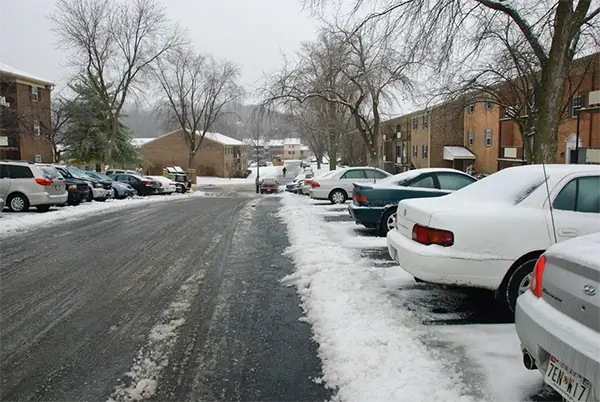
As a rule, winter is associated with the Christmas, Hanukkah and New Year’s holidays. This is truly an unforgettable and beautiful time of the year. At the same time, winter is challenging for many motorists, especially when it starts snowing heavily. Novice drivers experience the most difficulties when driving a car in the winter. Nevertheless, even experienced vehicle owners don’t like wintery conditions. So, what should you do if the heavy snowfall season has begun? Let’s figure it out and find out how you need to behave while driving during a blizzard.
Regardless of your driving experience, we advise you to refrain, if possible, from traveling in difficult winter conditions, especially for long distances. Thus, you will protect yourself from the danger of getting into an accident and salvage car auction. At the same time, if you can’t do without a car in a snowfall, then you just need to follow a few simple safety rules for driving a car on a snowy and slippery road to reduce the risk on the road.
Clear the Snow from Your Car Before You Drive
Many drivers, even experienced ones, often don’t completely clean their vehicles from snow and ice. Many of them, getting to the automobile in the morning, try to clean only the windshield, forgetting about cleaning the whole car, even though it is dangerous. After all, the snow that is on the roof can fly onto the windshield and rear glass while driving, which can impair visibility on the road.
Furthermore, a snowdrift on your car’s roof can impair the visibility of a driver in another car behind you. As a result, if you are followed by a not-very-experienced driver, they may not have time to reduce the speed when necessary and damage your automobile. Therefore, if your car is covered with snow, spend a few extra minutes cleaning it from snow and ice.
Winter Tires are a Must
Remember that even worn winter tires perform better in cold conditions compared to normal all-season ones. It’s all about the chemical composition of the rubber. Winter tires are designed for operation at low temperatures outside when all-season tires lose their properties in severe frosts. As a result, even old winter tires provide better traction than slightly older all-season ones.
In addition, winter tires have a different tread that provides better control of the car’s stability on the road. Also remember that when your vehicle is equipped with a four-wheel-drive transmission, it doesn’t give you better handling on the winter road, nor does it improve traction when driving. Remember that four-wheel drive gives an advantage only when starting the car from a standstill on a slippery road.
All Movements and Maneuvers Should Be Smooth
When driving on a slippery or snowy road, all your actions should be smooth. Remember that any sudden movements can disrupt the car’s stability and balance on the road. As a result, your vehicle may lose traction. Try not to accelerate or brake suddenly. Also, don’t turn the steering wheel sharply when driving. If your car has a winter driving mode, be sure to turn it on.
If your car is equipped with a manual transmission and you have difficulty starting from a standstill on a snowy road, then engage the second gear of the transmission and start moving. Thus, you will reduce the probability of wheel slippage and the risk of getting stuck in the snow.
Never Stop Trying to Avoid a Skid If You Lose Control of the Car
The first thing you should do when you lose control of the car is to take your foot off the gas pedal. Next, your task is to focus your attention on the part of the road where you want the vehicle to move during the skid.
Of course, this doesn’t give a 100% guarantee that you will be able to level the car. Nevertheless, this method increases the chances of not getting into a serious accident. The fact is that many of our actions while driving are carried out on a subconscious level and aren’t controlled by us meaningfully. Therefore, by concentrating our attention and our gaze on a certain section of the road, we increase the chances that the car will end up in the safest place after skidding and losing traction.
Never Engage Cruise Control in Poor Road Conditions
You should only use cruise control on dry and non-slippery roads. This driving mode is designed to maintain the speed set by the driver. At the same time, this system can’t take into account different road conditions. In snow or ice, control over the car should only be manual. After all, you will be able to take action as soon as possible in the event of danger to avoid an accident.
In addition, cruise control increases the likelihood of aquaplaning on a wet road, especially if water is mixed with snow on the track, and then a car begins to move like an air cushion. As a result, the vehicle will become uncontrollable due to a complete loss of traction.
When aquaplaning, it’s necessary to immediately reduce the engine speed by removing the foot from the gas pedal. At the same time, these actions will have the opposite effect with the cruise control on. As a result, you will have to sharply press the brake pedal, and an accident is inevitable then. Therefore, under no circumstances should you use cruise control in the snow or on slippery roads.
Drive At a Speed You Feel Comfortable With
Try not to accelerate too fast in the winter. If you feel apprehensive while driving, just reduce the speed to a comfortable level. When you are afraid, even if you are moving slowly, it’s best to avoid trips in difficult winter road conditions.
Remember that by driving slowly, you reduce the risk of getting into an accident. Keep in mind that when moving at a low speed, it’s necessary to move in the right row without creating an obstacle in the high-speed traffic lanes. So, if you feel uncomfortable on the road, try to slow down and don’t panic.
Safety is a Top Priority
When driving, any road user is responsible not only for their lives but also for the lives of others. The question of safety is most pivotal in the winter when blizzards and icy roads exist.In our article, you’ve had the opportunity to look through some tips and recommendations on how to make your driving in the snow more comfortable and safer. The key points are keeping an eye on the technical state of your vehicle, especially the wheels, simple pre-driving preparation, and planning your route wisely to avoid congested roads. If you are not sure about the characteristics of a used car you have – it is better to check out the history of the car. The easiest way is to use free license plate lookup. Follow these steps, and you will handle driving in the snow.







